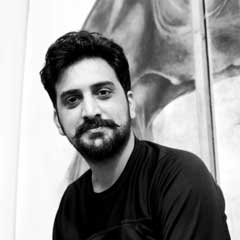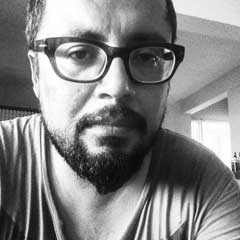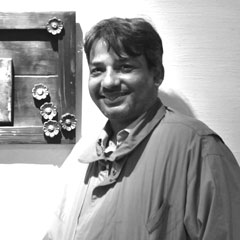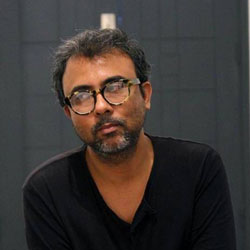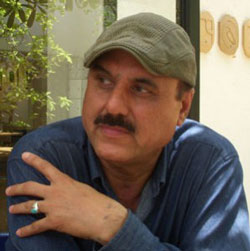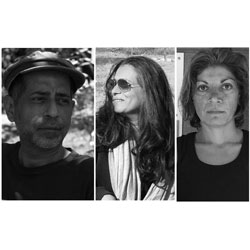2017 Karachi Biennale Artists
Aakif Suri
Born in 1982 in Dera Ghazi Khan (Pakistan)
Lives and works in Lahore (Pakistan)
In 2006 Aakif Suri procured a BFA in Miniature Painting from the National College of Arts, Lahore. He now works as an Assistant Professor at both his alma mater and the Pakistan Institute of Fashion and Design (PIFD), Lahore. His work has been shown both locally and internationally at a variety of group exhibitions, solo shows and art fairs, the latter including the Basel Art Fair, the Melbourne Art Fair and Slick Art Fair, Paris. Suri’s technical practice has very much been shaped by his training in miniature painting, the practice and popularity of which, since its reintroduction as a major subject to the NCA’s Fine Art curriculum in 1982, has experienced a dramatic resurgence. His art practice is informed by his rural upbringing in the generally underprivileged Dera Ghazi Khan district of the Punjab. This manifests itself in his work by reflecting and promulgating the issues, concerns and cultural sensibilities of his community, which often remain unvoiced due to its socio-political and demographical context.
SANAM is a work in which Suri expands on his sensitivity for naturalistic detail, acquired in his training as a miniaturist, on a larger scale. The work simultaneously plays with notions of ethnicity, technical tradition and the apportion of cultural significance. Whilst Suri’s work is somewhat of a departure from the technical tradition of contemporary miniature painting, the post-colonial derivative of the Mughal painterly tradition of musawwari, its influence is still conspicuous, even though the scale of the work is far from miniature. As Murad Khan Mumtaz writes: “In a global art economy, miniaturists are now encouraged to invoke ‘ethnic’ aesthetics; however, paradoxically, they continue to be influenced by and judged according to an established European canon.”[1] In this context, Suri’s departure in scale and subject matter clearly subverts this pressure to conform to the whims of the global art market. However, his subject matter, a modestly garlanded cow, directly refers to his ethnic background in which cows are of vital cultural significance due to the region’s cattle industry. The title of the work, SANAM, a name meaning ‘beloved’ in Arabic, further emphasises the symbolic importance of the cow depicted. In his work, Suri not only undermines the external categorisation of the technical tradition of miniature painting, he creates a visual metaphor for his ethno-cultural context within his highly-skilled aesthetic framework.
[1] https://www.guggenheim.org/blogs/map/miniature-painting-in-pakistan-divergences-between-traditional-and-contemporary-practice
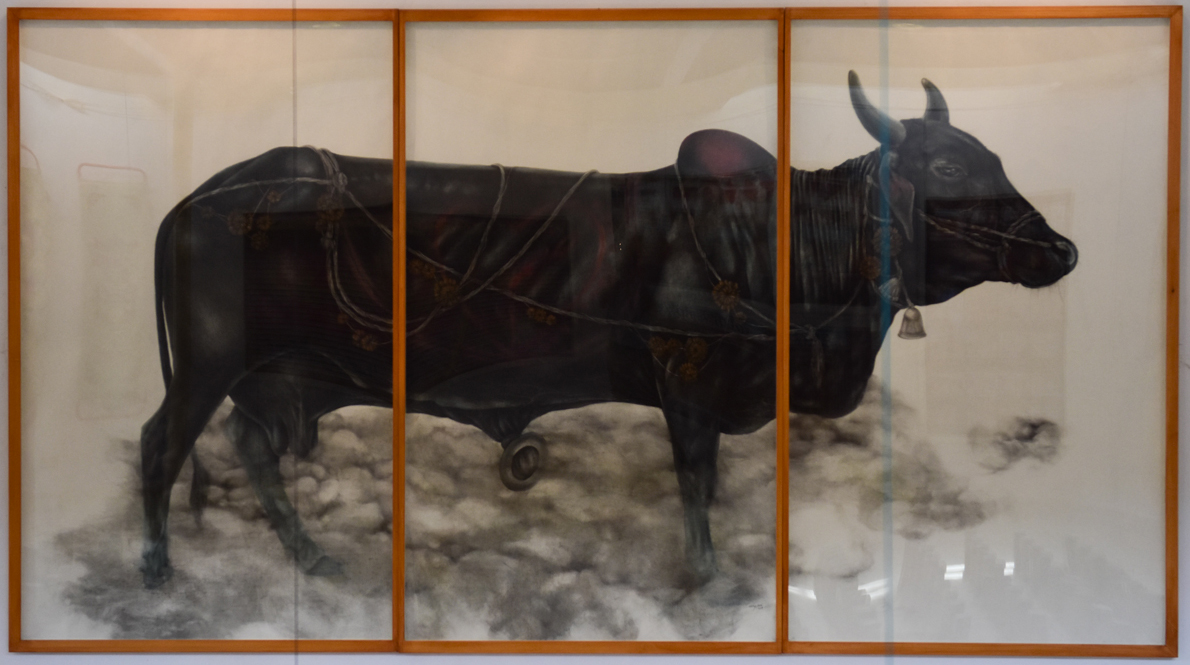
SANAM, 2017.
Graphite and powder pigment on archival paper
116 x 198 cm.
Courtesy the artist
Aamir Habib
Born in 1978 in Kohat (Pakistan)
Lives and works in Karachi (Pakistan)
Originally from Kohat, a small city in the Khyber Pakhtunkhwa province of Northern Pakistan, Aamir Habib graduated from the Indus Valley School of Art and Architecture, Karachi, in 2003. Specialising in sculpture, his work has been exhibited locally and internationally at venues such as: Canvas Gallery, Karachi; Koel Gallery, Karachi; ArtChowk the Gallery, Karachi; the Indus Valley School of Art and Architecture Gallery; Carbon12Dubai; and AB Gallery, Luzern. His work has also been shown at multiple art fairs, including: Scope Basel 2013, 2014; Abu Dhabi Art Fair 2013; and the Moscow Biennale 2014. His sculptures, installations and digital works, whilst ostensibly light-hearted and playful, are a satirical investigation and articulation of the ubiquitous socio-political paradoxes and contradictions in society. His art practice does not aim to make definitive statements, but rather to question, and comment on the abundant social, political and cultural inconsistencies and ruptures that have been caused by the powers that be, with little regard for the collateral damage caused to the affected civilian communities.
Habib’s sculptural installation for the Karachi Biennale 2017, Already Eaten, comprising of a taxidermied donkey and two television screens, is an homage to the working poor of Pakistan. Much like in Orwell’s Animal Farm, the hard-working horse, Boxer, is an allegorical representation of the Soviet proletariat, Habib’s donkey symbolises the working-class who, in the artist’s words, “have stretched themselves on hollow praise and broken promises since the dawn of independence.” The two television screens, playing the sound of people clapping, are a visual metaphor for the “hollow praise and broken promises” that give assurances of a brighter future, but never deliver, creating a system which negates social mobility.
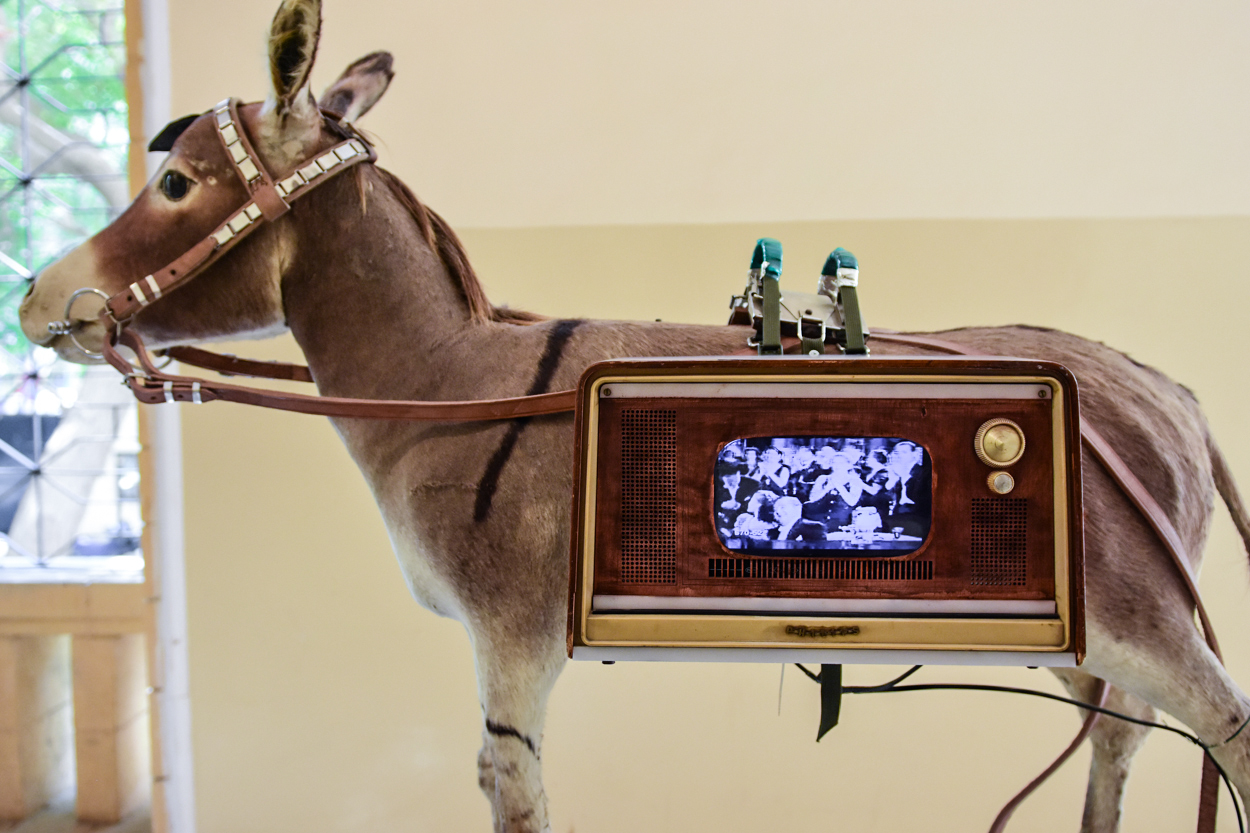
Already Eaten, 2017.
Taxidermied donkey, two television sets
183 x 152 x 123 cm.
Abdul Jabbar Gul
Born in 1969 in Mirpurkhas (Pakistan)
Lives and works in Karachi (Pakistan)
Abdul Jabbar Gull completed his BFA in Sculpture from the National College of Arts, Lahore in 1996. He has several solo and group shows to his credit. From 1998 to 2008 he taught sculpture at the Indus Valley School of Art and Architecture, Karachi and is still engaged with various institutes as visiting faculty. Gull attended the Fordsburg Residency Program, Johannesburg (2002); VASL International Artists’ Residency, Karachi (2005); 8th International Stone Sculpture Symposium, Seoul; Sculpture Symposium, Spain (2013) (2014) and (2015); and Arrecido Wood Symposium, Spain (2014). His work is part of collections nationally and internationally. He has completed several major commissions, including a mural for The State Bank of Pakistan, a metal sculpture for the Head office Faysal Bank in Karachi and a metal Installation for Glaxosmitithkline head office in Karachi. He is the recipient of the National Excellence Award for Sculpture by the Pakistan National Council of Arts and the Punjab Artist Association Award for Sculpture.
Abdul Jabbar Gull writes: “Growing up in Mirpurkhas, a remote area in Pakistan that does not have any conventional art activities associated with larger towns, I remember on my way to school seeing a sign painter that used to work in calligraphy and make portraits. Watching him at work motivated me to attempt calligraphy and make sketches on my schoolbooks. Later, as an art student at the National College of Arts, Lahore, I explored various disciplines. In sculpture I found what I had been searching for all along. It helped me develop my senses and increased my awareness towards the world around me. I learnt to see and feel my surroundings in an entirely new way. I found my passion…I find wood and metal to be sympathetic mediums; they help me to enhance my quest and continue it. My carvings in wood set out to explore numerous questions arising from the changing circumstances of my life. I have no conclusions, so my work speaks of the mysteries and ambiguities faced in this process.”
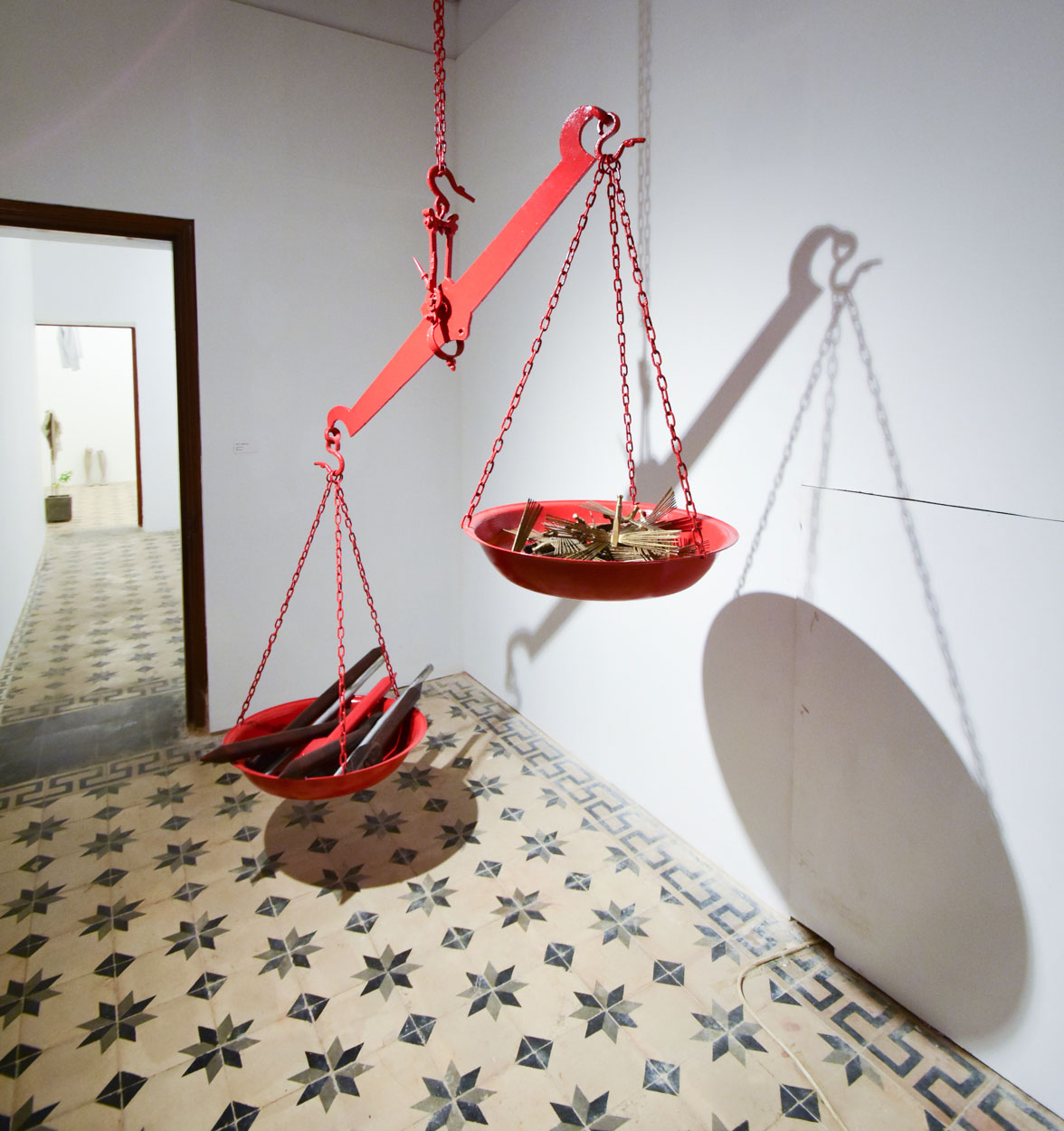
Ordinary Souls, 2017.
Wood, brass and aluminum
167 cm high
Courtesy the artist

Abdullah M.I. Syed
Born in 1974 in Karachi (Pakistan)
Lives and works between Karachi, Sydney (Australia) and New York (USA)
Abdullah M.I. Syed
Born in 1974 in Karachi (Pakistan)
Lives and works between Karachi, Sydney (Australia) and New York (USA)
Abdullah M.I. Syed holds a PhD in Art, Media and Design (2015) and a Master of Fine Arts (2009) from the University of New South Wales, Sydney. He also holds a Master of Education (2001) and a Bachelor of Art in Design (1999) from the University of Central Oklahoma (UCO), USA. Syed also coordinated the Department of Design at Karachi University and has lectured at UCO and UNSW Art & Design. Syed’s works have been featured in ten solo exhibitions and several national and international curated group exhibitions and performance events such as Asia TOPA: Asia-Pacific Triennial of Performing Arts, Melbourne (2017), Substitute, Fairfield City Museum and Gallery, Sydney (2016), Between Structure and Matter, Aicon Gallery, New York (2016), 48HR Mass Group Incident, 4A Centre for Contemporary Asian Art, Sydney (2015) and The Rising Tide, Mohatta Palace Museum, Karachi (2010) to name a few. He has also participated in numerous art fairs including Art Central, Hong Kong where he performed The Flying Buck. Syed’s work is also held in many private and public collections notably Devi Art Foundation, AAN collection, Casula Powerhouse and the US Art in Embassy Islamabad. Syed’s awards include the Blacktown Art Prize (2010), the UNSW Postgraduate Research Scholarship (2009) and the IAO Installation Art Award (2003).
Bucking is Abdullah M. I. Syed’s live performance in which he consumes and regurgitates a menu of fresh uncirculated banknotes and addresses the weightiness of the effects of over exerting economical power that no one is immune to. Since first performing the piece in Karachi in 2011, Syed has performed Bucking in multiple cities around the world including Sydney, Australia at 4A Centre for Contemporary Asian Art in 2015. By presenting a video archive of this performance at KB17, Syed pays homage to the performance returning to its place of origin – Karachi, the financial hub of Pakistan. Bucking is a fascinating and at times confrontational look at the central role money plays in economies of consumption and exchange and how money often navigates cultural and political identities and power structures. In the video, the US dollar bill becomes a dominant instrument of addressing complex renderings of the dysfunctions of global market economies, the dissemination of power, and intrinsic neo-colonial concerns. Where the body of the artist is in immediate play, occupied in acts of repetition and endurance, so too is the larger body of the audience, who become witnesses of this seemingly playful but so often violent act.

Still strip from Bucking: Sydney, 2015.
Video documentation of live performance, 15:23 min.
Courtesy the artist and 4A Centre for Contemporary Asian Art, Sydney
Photography: Zan Wimberley
Artist portrait: Mim Stirling
Adeel uz Zafar
Born in 1975 in Karachi (Pakistan)
Lives and works in Karachi (Pakistan)
Adeel uz Zafar is a multi-disciplinary artist and illustrator, based in Karachi. Having obtained a BFA (with distinction) from the National College of Arts in 1998, his initial trajectory led him towards illustration, which has proven highly influential in his artistic practice. Whilst working as National Illustration Consultant for the Northern Areas Education Project in remote areas of Northern Pakistan, the absence of conventional artistic media forced Zafar to experiment with substitutes for paints and surfaces, precipitating the development of his characteristically reductive technique by engraving on exposed photographic sheet. Through obsessive repetition of this simple action of mark-making, he creates intricately textured forms imbued with a meditative and contemplative aesthetic. Zafar’s work has been exhibited nationally and internationally, with venues and art fairs including: Hinterland Galerie, Vienna; Lawrie Shabibi, Dubai; Art Stage Singapore; Art Basel, Hong Kong; Pulse Art Fair, New York; and the 2nd Kathmandu International Art Festival. Zafar has also held several national and international solo exhibitions, among them: Stranger than fiction at Gandhara-Art, Karachi; Monomania at Aicon Gallery, New York; and Protagonists at FOST Gallery, Singapore.
Zafar’s installation for the Karachi Biennale 2017, Tombstones/Katbay, which he created along with Noman Siddiqui and Hasnain Ali Noonari, explores the silent testimony of tombstones to the context of Karachi. The assiduous process of creating the work began by gathering photographic documentation from 182 graveyards in Karachi, spanning the geographic, ethnic, religious and socio-economic divides of the inherently diverse megacity. Zafar then transposed the selected cenotaphic inscriptions onto cardboard lightboxes – in most cases the deceased's name, date of birth, and date of death, epitaph, or prayer, at times containing pieces of funerary art in stone relief. In doing so, the artist has created his own microcosm of silent witnesses to Karachi’s historical and contemporary context; a multitude of engraved voices entering into a dialogue between memory and present actuality, each individual playing their own part in the unfolding history of cultural identity and coexistence. A site-specific installation, Zafar’s aesthetically adhesive representation of socio-cultural division, subverted by the collective tolerance of his postmortem community perfectly corresponds to its venue, The Theosophical Society of Karachi, one of the key tenets of which is: “To form a nucleus of the universal brotherhood of humanity without distinction of race, creed, sex, caste, or colour.”
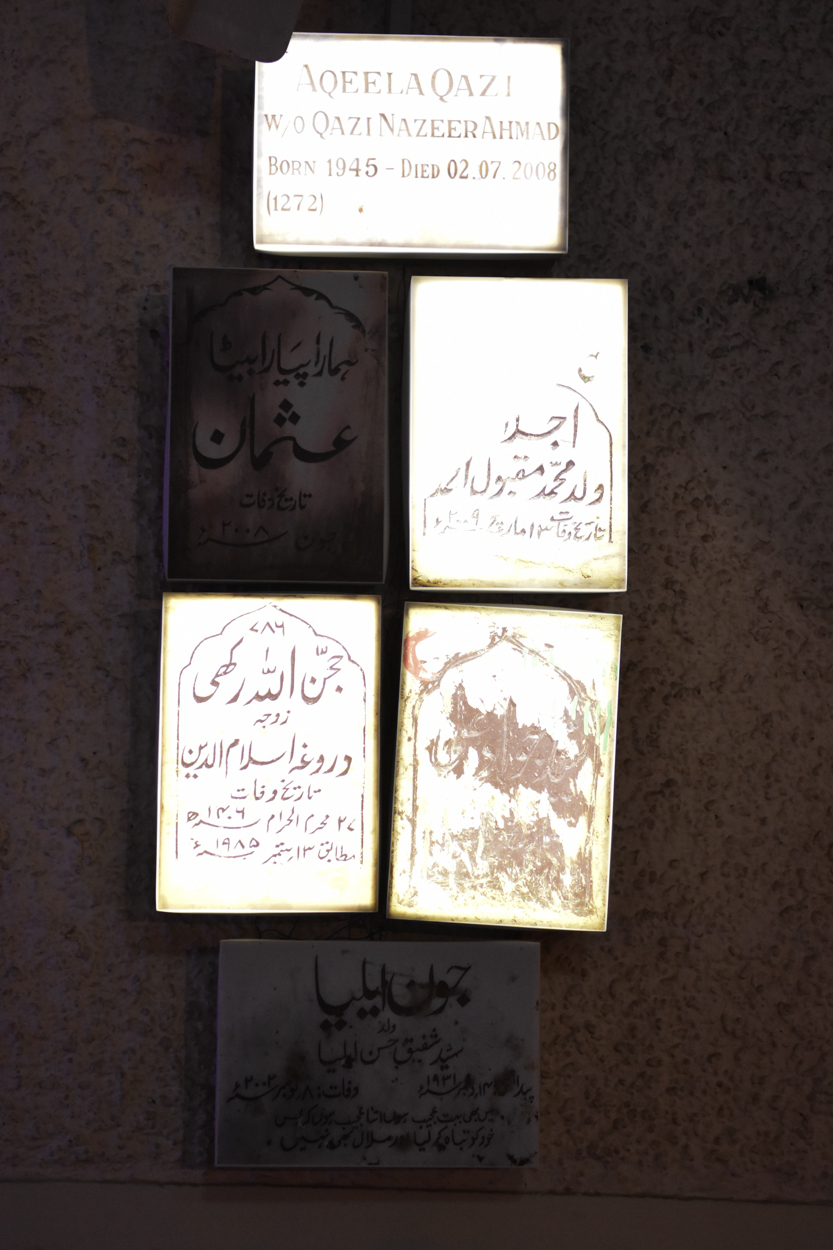
Tombstones/Katbay, 2017.
Light boxes made with cardboard, LED light, print on transparent paper
Dimensions variable
Adeela Suleman
Born in 1970 in Karachi (Pakistan)
Lives and works in Karachi (Pakistan)
Adeela Suleman received her BFA from the Indus Valley School of Art and Architecture, Karachi in 1999 and before that did her MA in International Relations from Karachi University in 1995. Currently Suleman is Associate Professor and Head of the Fine Art Department at the Indus Valley School of Art and Architecture, Karachi and is Coordinator of Vasl Artists’ Association, Karachi. Suleman has exhibited in numerous solo exhibitions, most recently at Gandhara Art Gallery, Karachi (2017); Aicon Gallery, New York, USA (2017); Davide Gallo Gallery, Milan, Italy (2017); Canvas Gallery, Karachi (2015); Aicon Gallery, New York, USA (2014); Canvas Gallery, Karachi; (2012); Alberto Peola Gallery, Turin, Italy (2012); Aicon Gallery, London, UK (2011); and Rohtas Gallery, Lahore (2008). She has also taken part in group exhibitions at notable Museums and foundations including, Pinakothek Der Morderne, Munich, Germany; Gaasbeek Castle Museum, Brussels, Belgium; A4 Centre for Contemporary Asian Art, Sydney, Australia; Singapore Art Museum; National Taiwan Museum of Fine Arts, Taichung, Taiwan; Asian Art Museum, San Francisco, USA; Devi Art Foundation, Gurgaon, India; and the Asia Society, New York, USA, among others. Her works are part of notable international public collections.
Adeela Suleman sees her works as biographical, in the sense that what she makes tells us something about who she is and where she comes from. She is deeply rooted in tradition, culture and religion, yet she is also acutely aware of the urban and political realities that surround her in modern day Karachi. In her work the formal and sociological aspects of these two parallel worlds come together as a poetic document to her life. Adeela Suleman draws attention to troubled sectarian and gang-led violence in Pakistan. Drawing from the tradition of Islamic art, Suleman moulds hardened steel and co-opts found objects to memorialize the countless killings within her country. Of her work on view at KB17, Suleman writes: “The continuous and escalating cycle of violence and unrest plaguing Pakistan is not only leaving its mark on the awareness and memories of individuals, but has begun seeping into every space and landscape of its citizens’ daily experiences and collective consciousness.”

Falling Down, 2012.
Stretcher, stainless steel, powder paint
185 x 350 x 13 cm.
Courtesy the artist
Affan Baghpati/Syed Arsal Hasan
Affan Baghpati (b. 1991, Karachi) obtained his BFA from the Indus Valley School of Art and Architecture, Karachi, and completed his Master’s in Art and Design Studies at SVAD, Beaconhouse National University, Lahore. Baghpati’s art practice is concerned with re-contextualising discarded domestic objects into the artistic sphere, identifying their notional value through their design, aesthetic, form and functionality. Syed Arsal Hasan (b. 1989, Karachi) is a theatre director, actor and playwright, as well as one of the founding members of the Mandarjazail Collective. He graduated from the Indus Valley School of Art and Architecture with a Bachelor’s degree in Communication Design. Arsal’s artistic practice draws its inspiration from the writings of Faiz Ahmad Faiz and Mirza Ghalib as a way of examining South Asian culture from a structuralist perspective. His work is deliberately designed so that it transitions with fluidity between film, theatre and art with a malleable visual vocabulary.
Their collaborative sculptural installation for the Karachi Biennale 2017, Aasaih-e-Manzil, is an artistic response to Faiz Ahmad Faiz’s poem, ‘Do Ishq’ (Two Loves). Using abandoned objects to symbolise the personified ‘motherland’ that Faiz yearns for in his verse, the duo visually transpose the notion of cultural vulnerability and loss latent in the poem. The arrangement and composition of the objects aesthetically recalls the structure of poetic verse, and the selection of the objects themselves imbues the structure with a contemplative, nostalgic tone that somehow atmospherically transports the viewer to a forgotten past.
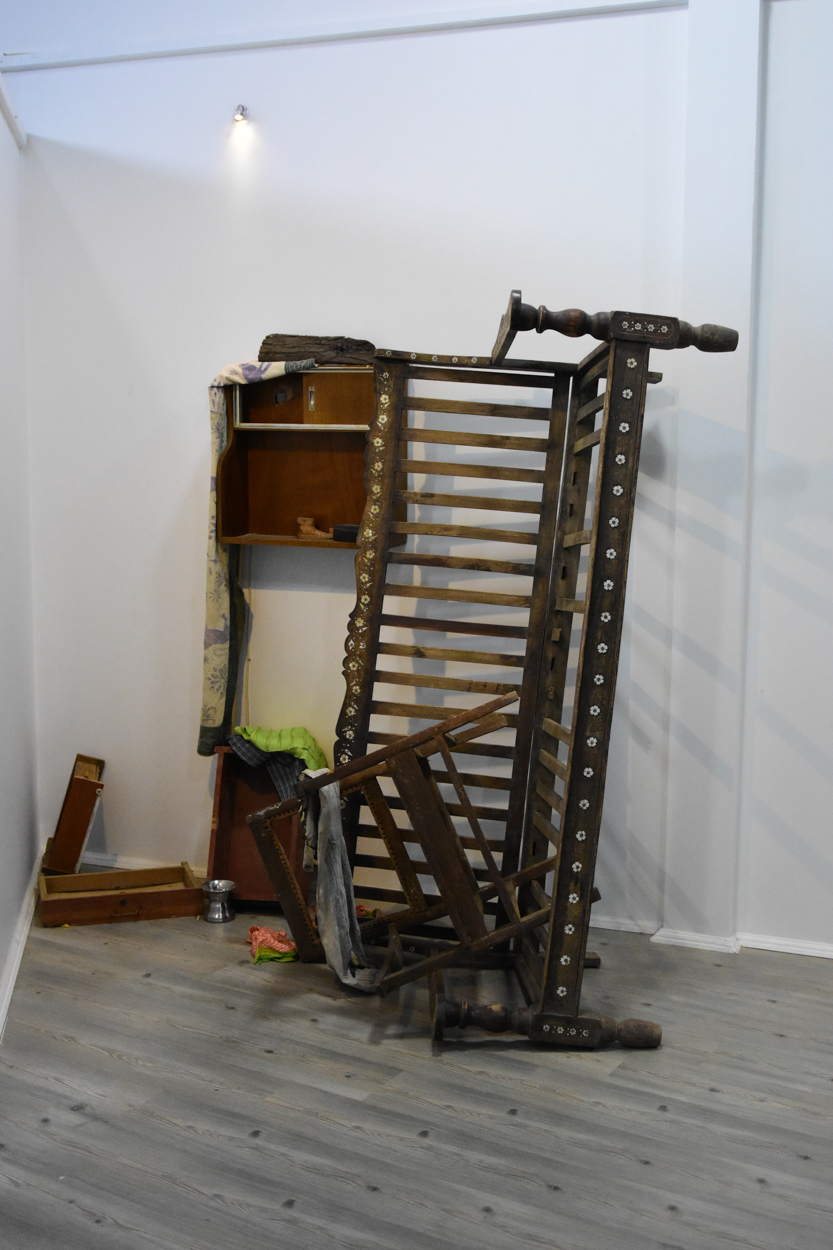
Aasaih-e-Manzil, 2017.
Found objects, furniture.
Dimensions variable
Afshar Malik
Born in 1955 in Bahawalpur (Pakistan)
Lives and works in Lahore (Pakistan)
Afshar Malik received a BFA from the National College of Arts, Lahore in 1978 and a Higher Diploma in Fine Arts from the Slade School of Fine Arts, London in 1988. He taught at the National College of Arts, Lahore from 1983 until his retirement in 2015. Malik has had solo shows in Karachi, Lahore and Islamabad and has participated in numerous group exhibitions in Pakistan, the UK, the US, Iran and Sri Lanka. He has participated in workshops in Karachi and Mumbai and conducted several workshops in Lahore.
Afshar Malik writes of his painting Far Away Now for KB17: “Once, we began to say what we knew and write our own histories of the lives we were living. Coming of age, as it were, at forty, we walked up and down, negotiated and redefined our preferred ascents and descents of life. History was written right there and then, on the same page, with invisible inks of memory and anticipation—everything, like scales, numbers, erased or unscratched stories from the past and future, road maps, mediums and their methods to practice. History appeared like a photograph, a mirror, or a flower in our hands, telling one’s own self a story and writing the sounds from the past. Life is always on the move to varied ascents—or descents—every second, every moment. One ‘falls’ down and follows one’s own descent. The age of realization is marked—one has to choose, walk down the hill to where one started, back to the waters and be a fire to warm it. ‘I’m the eyes’, she said once.…and said, ‘we live, we fight to survive and keep the very true instinct in us alive so as to keep the blood warm in our veins’. This is about those people who dared to think and took pride in becoming and being—lone fighters, combating in the battlefield of life or fighting the war against dying. They also believed in their core that the war was not meant to be won or lost—it was the struggle which made them go on and gave them strength. To live and breathe, to sing a song while making a mark with a stitch, a non-ending thread twisting and turning to form a living pattern. A thread holds a needle, weaves their tears and gives moisture to a dry cloth.”

Far Away Now, 2017.
Oil and acrylic on canvas
168 x 137 cm.
Courtesy the artist
Agha Abbas
Born in 1969 in Karachi (Pakistan)
Lives and works in Karachi (Pakistan)
Agha Abbas has been in the media industry for the past 20 years and has extensive experience in Photography and Video Production. He writes: “When I started out there were no non-linear editing machines or LCD monitors on cameras and the closest thing one had to a portable flash drive was a 1.44Mb floppy disk. The technology has come a long way since. My love for the camera (and art in general), is not far from what should have been expected. My (Late) father, Agha Sadaruddin (RIP), was a Time and Life photographer, a documentary filmmaker par excellence and younger brother to the legendary Gulgee. My earliest memory is that of begging my father to let me agitate this tray filled with some ‘magic water’ (developer), in which dipping a plain piece of paper (after being exposed to a projected image from an Enlarger), resulted in an Image emerging on it. Sheer magic it was! It must have been such encounters that got me to fall for the art of photography at a very early age.”
In his photographs for KB17, Agha Abbas calls forth multiple, layered stories of an industrialized landscape. Architecture is more than buildings alone. It is also the shadows they cast on the ground and on structures surrounding them, the ambient lights that play off their facades and windows, the scaffoldings and piles of discarded rebar that have yet to be removed from their building sites. It is the stories, mostly unheard, of the labourers who rise at dawn, travelling long distances to toil.

Untitled, 2017.
Digital photograph
81 x 122 cm.
Courtesy the artist
Aisha Abid Hussain
Born in 1980 in Peshawar (Pakistan)
Lives and works in Lahore (Pakistan)
Aisha Abid Hussain is a multi-disciplinary artist who works in a variety of mediums, from Miniature Painting to Photography and Film. She obtained her MFA from Goldsmiths College, University of London, in 2012, and her BFA from the National College of Arts, Lahore, in 2008. She is a recipient of various scholarships and awards including Hajji Sharif Award in Miniature Painting from the National College of Arts, and New Contemporaries from ICA, London. Her work has been exhibited extensively throughout the world and in Pakistan, and she has held numerous solo shows, at venues including: Rohtas 2, Lahore; The Loft at the Lower Parel, Mumbai; Koel Gallery, Karachi; Hanmi Gallery, London; Gandhara Art Space, Karachi; and Alexis Renard Gallery, Paris. She is currently an Assistant Professor at the National College of Arts and Beaconhouse National University, Lahore. Hussain’s art practice is very much research-based, derivative of her fascination with personal and worldly history. Thus, a crucial aspect of her creative process comprises of excavating through archival documents, scripts, photographs and text. A constant point of reference in her technical practice is her training as a miniaturist, and by using this engrained sensibility, she oscillates between traditional and contemporary media in order to visually explore forgotten narratives she has discovered through archival research in her work.
Aisha Abid Hussain’s series of digital photographs, Two Not Together, expands on her artistic interest in the socio-cultural context of gender discourse, gently mocking societal fixation with wedding celebrations. Her works have been inspired by photographs found in a familial archive, and are consequently imbued with a pseudo-nostalgia that furthers the satire in her re-staging of the original ceremony. The composition of the photographs is carefully arranged, not only referring back to Hussain’s archival source, but capturing the gender politics and power dynamic between the betrothed in their roles of ‘bride’ and ‘groom’. This is ultimately subverted by the fact that both parties in the photographs are female, but with costume, gesture and stance as gender signifiers, subtly critiquing the contextual rigidity of the institution of marriage.

Two Not Together, 2014.
Archival print on Hahnemuhle photo rag
83.82 x 59.69 cm.
Collection of the artist
Akram Dost Baloch
Born in 1958 in Nushki (Pakistan)
Lives and works in Quetta (Pakistan)
Akram Dost Baloch was born in Nushki, a border town in the south-west of Balochistan province of Pakistan, and received his school education there. He graduated with his BFA from National College of Arts, Lahore, and is among the founding faculty of The Department of Fine Arts, University of Balochistan. He paints and sculpts and the themes of his work are wide ranging, with a heavy focus on human rights. The dominant aesthetics of his work are inspired by the traditional motifs of Balochistan, an area to which he has contributed much himself; Baloch wrote his PhD dissertation on the traditional patterns of Baloch embroidery and handicrafts, and has contributed invaluable items to the collection on Balochistan at the Mohatta Palace Museum in Karachi. Baloch has received wide acclaim, both at home and abroad, and is also the recipient of Pakistan’s President’s Pride of Performance award (2004). He is currently based in Quetta where he runs his studio and chairs The Institute of Fine Arts at University of Balochistan.
Akram Dost Baloch has an installation of 40 wooden boxes that he has carved upon on view at KB17. He writes: “Art for me serves two functions; first comes its redemptive quality, and second, its capacity to bear witness to, and speak for the despairing side of human existence. While the first raises us, it is only with a keen perception of the latter that the aching need for and the requisite perception to find redemption can be attained. Such has been the prime motive for my practice over these many years. My submitted work comprises 40 boxes, all of which I have carved with engraved compositions. The history of these boxes, which I purchased at an auction in Quetta, is a curious one: these were used by the British army for ammunition storage and languished in bunkers and warehouses at the Quetta fort after their departure in 1947. Quetta Fort itself was a military garrison built by the British upon the mound of an extant Qila (fortress) and served as the Raj’s furthermost western military station. The Qila, the British, the ammunition caches, and the cultural and political upheavals that have plagued the region since readily tie into a narrative that is not completely foreign to the themes of my work; their arrival and the legacy of their departure haunt the political, social and cultural developments of the subcontinent to this day.”
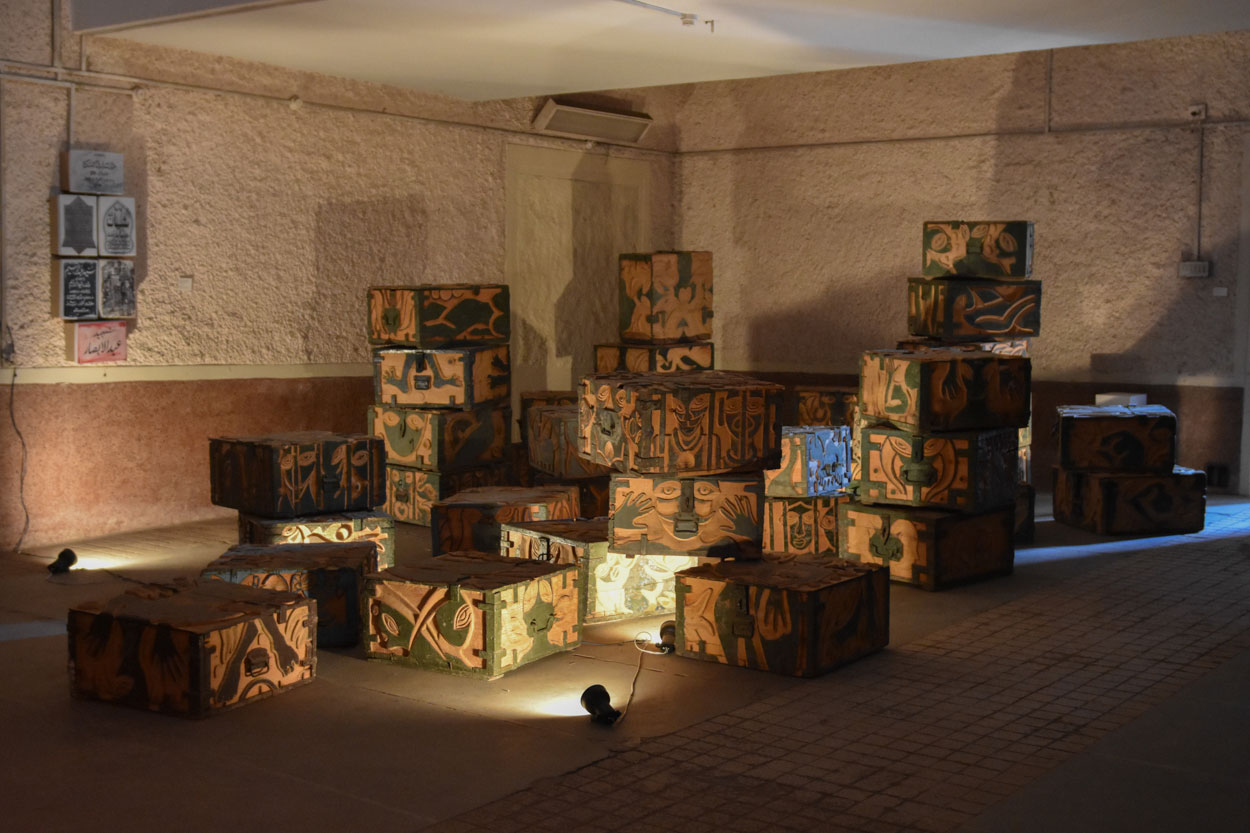
Of Yore and Lore, 2017.
Mixed media installation
Dimensions variable
Courtesy the artist
Ali Azmat
Born in 1973 in Multan (Pakistan)
Lives and works in Lahore (Pakistan)
Ali Azmat received his BFA from the University of the Punjab, Lahore, in 1997. He then went on to complete his MFA (in painting), in 1999, and his M. Phil in Fine Arts (studio practice), in 2015, from the same institution. His work has been shown in numerous group exhibitions, and he has mounted several solo exhibitions, both nationally and internationally. Azmat received the National Excellence Award from the Pakistan National Council of Arts in 2003. His artistic practice embraces the aesthetics of both the figurative and landscape painterly traditions of the Punjab. He frames this traditional sensibility within a truly contemporary and relevant oeuvre of subjects, exposing existent social hierarchism and exploring the concepts of the ‘local’ in a nuanced manner that subverts current artistic trends in peripheral visual culture toward pandering to notions of neo-exoticism.
Dangal, Azmat’s painting for the Karachi Biennale 2017, derives its subject matter from his father’s obsession with Akhara culture throughout the artist’s formative years. Azmat explains: “The influences, inspirations and even the morals of the Akhara culture were in practice in our home. In this context, the psychological patterns of my youth developed into series of symbols and metaphors that I have subjectively interpreted and furnished in my artwork.” The work is fecund with dichotomy and contrast, representing the inherent contradictions in societal stratification. Azmat’s depiction of a strident, muscular and rigid figure is a visual embodiment of masculinity, and the Dangal’s placement in an antithetically contemplative and emollient setting highlights the inherent chauvinism of such a sub-culture. The painting, however, transcends such a specific critique, metonymously manifesting the hypocrisy and multitudinous contradictions imbued within any form of structuralised misogyny.

Dangal, 2017.
Acrylics on canvas
122 x 91 cm.
Courtesy the artist
Ali Kazim
Born in 1979 in Pattoki (Pakistan)
Lives and works in Lahore (Pakistan)
Ali Kazim received his BFA from the National College of Arts, Lahore, in 2002, and his MFA from the Slade School of Fine Art, London, in 2011. He has received a number of awards, including: Finalist for the Catlin Prize, UK; The Land Securities Studio Award, London; Young Painter Award, Lahore Arts Council; and the Melvill Nettleship Prize for Figure Composition, UCL, London. He has also participated in numerous art residencies, such as: The Art House Residency, Wakefield; Art OMI Artist Residency, New York; ROSL Travel Scholarship: Residency at Hospital Field, Scotland; Vasl Residency (Triangle Arts Trust), Karachi; and the International Artist Camp, George Kyet Foundation, Sri Lanka. His work has been exhibited extensively, both nationally and internationally, in group and solo shows, as well as in various collections around the world, including: the Metropolitan Museum, New York; the Pacific Asia Museum, Pasadena; the British Museum, London; the Victoria and Albert Museum, London; Queensland Art Gallery, Brisbane; the Burger Collection, Hong Kong; Creative Cities Collection, Beijing; the Kiran Nadar Museum of Art, New Delhi; the Devi Art Foundation, New Delhi; and the Samdani Foundation, Dhaka. He currently teaches in the Department of Fine Art at the National College of Arts, Lahore. The crux of Kazim’s multi-disciplinary artistic practice is the sensitive selection of materials in order to articulate the subject most efficaciously. This manifests itself in his work in the wide-range of media and technical practices that he utilises to investigate the multi-faceted, substructural elements of our everyday world.
In his untitled installation for the Karachi Biennale 2017, Kazim has used human hair to create a three-dimensional drawing in the space. The work derives from the artist’s interest in the complexity of the human body, both in its physiognomy and as a thematic concern. His selection of human hair as the material for his work reveals the basis of his artistic practice, which strives to utilise the most effective, yet often obscure material to depict his subject. In this case, he has used hair, by its nature an exterior feature of the human body, to represent the structure of the body’s interior world. By doing so, he has created a dialogue between the interior and exterior; whilst we can visibly perceive our hair growing, unable to consciously control its incremental growth without cutting it, we can very rarely perceive the constant internal function of our bodies. Thus, by using hair to represent the interior structure of our bodies, Kazim exteriorises the internal, just as the growth of our hair makes our constant bodily function visibly perceivable.
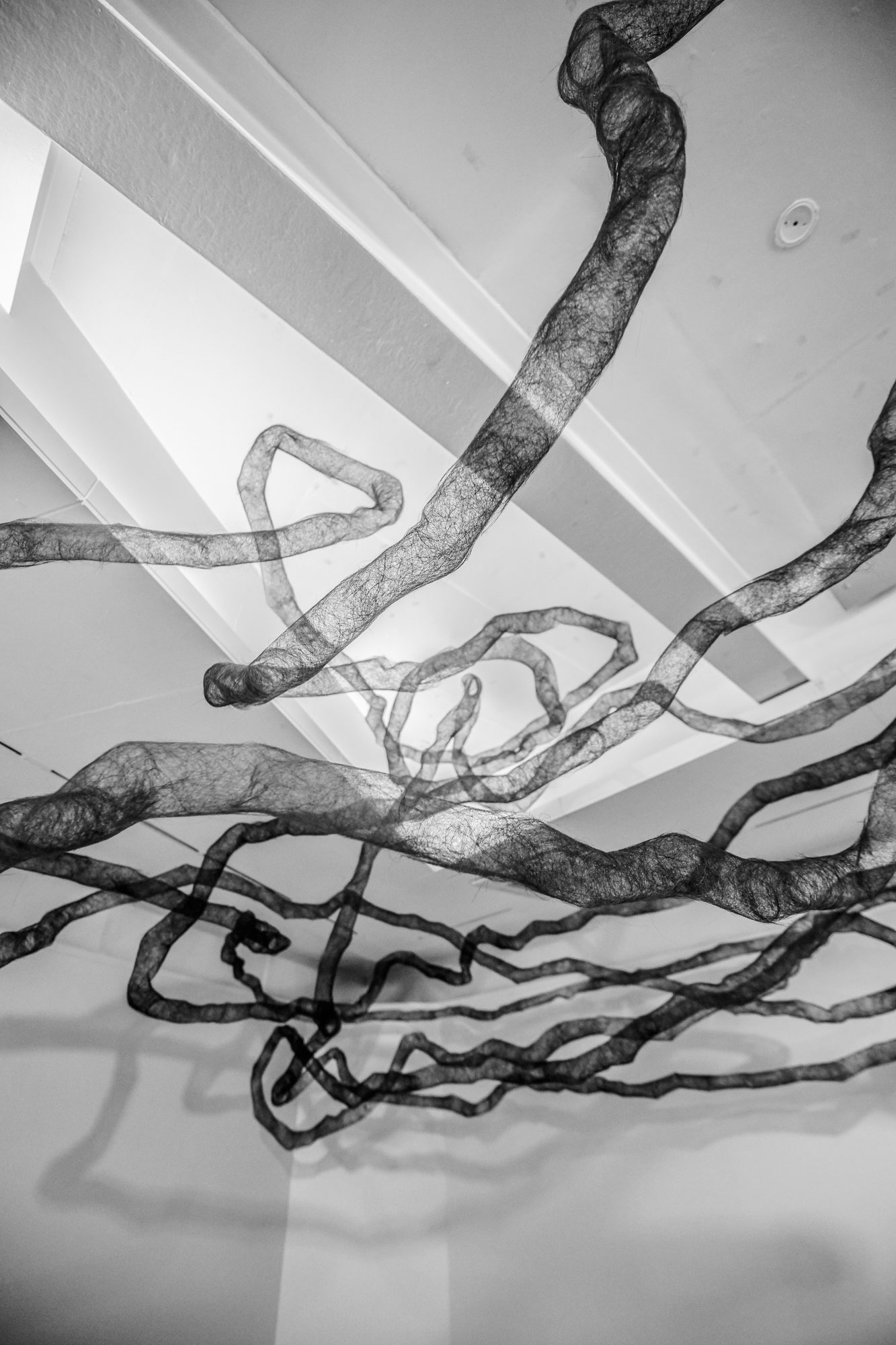
Untitled, 2011.
Hair, hairspray, invisible thread
Dimensions variable
Courtesy the artist
Althea Thauberger
Born in 1970 in Saskatoon (Canada)
Lives and works in Vancouver (Canada)
Althea Thauberger took degrees in photography and studio arts at Concordia University (2000) and the University of Victoria (2002), and studied media philosophy at the European Graduate School in Saas Fee Switzerland (2009/10). She has taught art and theory in many post secondary institutions including Simon Fraser University, Vancouver; Concordia University, Montreal; and the Art Academy of Prague. She is currently a guest lecturer in the Liberal Arts Program at the Indus Valley School of Art and Architecture in Karachi. Working in photography, film/video and performance, her practice is concerned with collaborative possibilities of the social documentary form. Her recent film projects have involved research and engagement with particular sites and their communities to generate a performance-based narrative. The resulting films reflect on social, political and institutional power relations and present situations in which these dynamics may be challenged or break down. Her screenings and exhibitions include the Audain Gallery, Vancouver; the 2012 Liverpool Biennale; the 17th Biennale of Sydney; La musée d'art contemporain de Montréal; The National Gallery of Canada; The Berkeley Art Museum; Manifesta 7; Overgaden Institute of Contemporary Art, Copenhagen; BAK, basis voor aktuele kunst, Utrecht; The Power Plant, Toronto; and the 3rd Guangzhou Triennale among many others. She is represented by Susan Hobbs Gallery, Toronto.
Althea Thauberger has two works on view at KB17: a photograph entitled “Who is that cane tell me who I am?” and a digital film paired with a painted movie billboard. The film features the built environment of Capri Cinema's modernist architecture and its security modifications, along with a cast of approximately 200 extras. The Capri is one of only two remaining single screen projection houses remaining in Saddar, Karachi's city centre, and it remains a fully functioning cinema despite many difficulties and attacks, including a mob fire attack in 2012. The cast of the film will be drawn from the cinema's existing patrons as well as from the diverse community of residents directly surrounding the site. The scenes are generated through a workshopping process and will relate to the remarkable history of the site.

Pagal Pagal Pagal Pagal Filmy Duniya (Mad Mad Mad Mad Filmy World), 2017.
Digltal film (29:00 min.) and painted billboard (304 x 914 cm.)
Courtesy the artist and Susan Hobbs Gallery, Toronto
Amy Kingsmill
Born in 1991 in London (UK)
Lives and works in London (UK)
Amy Kingsmill is a London-based performance artist producing both pain-based ritualistic performance and strongly visual works which present costume as an installation on the body. She creates her own mythology through performance, drawing upon her own internal cast of characters or using performance to push her body through self-designed rituals. Since graduating from Central Saint Martin's in 2013 she has performed at Spill Festival of Performance (2014), Franko B's Untouchables, and recently presented a collaborative work, Tender Blood, with Sheree Rose.
Of her performance on view for KB17 Amy Kingsmill writes: “Fairytale draws upon the romanticisation of relationships, how we can write our own fairytales within them and the reality of these fables maybe purely based on your own dedication to this narrative. I reflect upon what we can sacrifice for our relationships to sustain them or the fantasy of them and the dependency resultant from this. The flowers after the performance will be kept on display on a plinth.”

Fairytale, 2017.
Performance
20 min.
Antonio Puri
Born in 1966 in Chandigarh (India)
Lives and works in Bogota (Colombia)
Antonio Puri was raised in the Himalayas and attended the Academy of Art in San Francisco and Coe College in Iowa for a Bachelor’s in Art and later a JD degree from the University of Iowa. He has had solo exhibitions at Government Museum and Art Gallery, Chandigarh, India; artdepot, Innsbruck, Austria; The Guild Art Gallery, New York; The Loft, Mumbai, India; Nu Art Gallery, Santa Fe; Twelve Gates, Philadelphia; Philadelphia Art Alliance; and a two person show at the Noyes Museum, NJ, USA. He has also participated in numerous group exhibitions. Puri’s expression of the self continuously evolves in an effort to challenge perceptions and deconstruct identifying labels used by others. He is particularly interested in the connections between his Eastern roots and his Western experiences. He embraces the possibility that we can exist in a world free from labels.
Attaching Detaching, Puri’s submission for KB17, comprises of photographs centered upon the insistent gesture of tying the body and face. With this, the artist reflects on the ideological ties that arise due to cultural schemes that relegate us to an existence loaded with paradigms that distort our communion with life and others. In the work, the body becomes a territory invaded by suppositions. In this context, the act of tying emphasizes that we are all prisoners of our circumstances, while the act of untying manifests as a decisive act of freedom. The work alludes to the multiple and often violent ties of the mind and the flesh and our desire to be free of them.
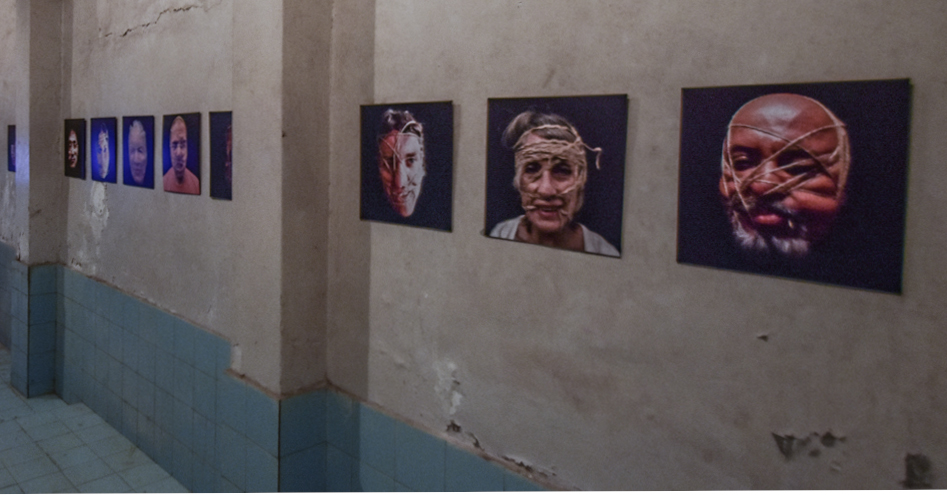
Attaching Detaching, 2017.
Photographic installation
Dimensions variable
Courtesy the artist
Anum Jamal
Born in 1988 in Karachi (Pakistan)
Lives and works in Karachi (Pakistan)
Anum Jamal received her Bachelor’s in Fine Art from the Indus Valley School of Art and Architecture, Karachi in 2012 and was the recipient of the Zahoor ul Akhlaq Award for Best Drawing Portfolio, after which she received her Master’s in Contemporary Art Practices from Coventry University, UK in 2015, both degrees with distinctions. She has had solo shows at Althorpe Galleries, UK and Koel Gallery, Karachi. Her works have also been showcased in several group shows in the UK, US, Italy and Pakistan, most notably The Young Masters Art Exhibition in Cynthia Corbett Gallery (UK) and The Salon Presents ETA (UK). She currently teaches at the Indus Valley School of Art and Architecture as a Senior Lecturer in the Liberal Arts Department.
Anum Jamal writes of her work created for KB17: “Repetitive schedules, rules, laws and regulations, jobs, and security measures dog our everyday lives. The uncertain political situation makes us yearn for the mundane.” Locus questions the notions of tedium and monotony and whether they are a luxury or a struggle. The work is based on the physiognomic profiles of the strangers the artist comes across daily and how they impact the architecture of our lives. Jamal believes that each of these strangers has something unique that needs to be highlighted.

Locus, 2017.
Digital drawing, graphite and colour pencil on paper and foam-board
183 x 183 x 152 cm.
Courtesy the artist
Anwar Saeed
Born in 1955 in Lahore (Pakistan)
Lives and works in Lahore (Pakistan)
Anwar Saeed graduated with a BFA from the National College of Arts, Lahore in 1978 and completed his postgraduate studies at the Royal College of Arts in London. He has exhibited widely in Pakistan and has participated in group shows in the US, Australia, Norway, Egypt, Jordan and India. He has been Associate Professor at the National College of Arts, Lahore since 1986.
Anwar Saeed has submitted a painting for KB17. He writes of his wider practice: “Parallel to all kinds of changes in medium, technique, materials and more, what I can see as almost constant in my work, over the years, is the presence of figure--the physicality of it. The pleasure of drawing and painting the body is the thing that keeps me coming back to my work. It also appears as a site where you can locate discussions of marginality, dispossession, love, betrayal, sin, violence, death and rebirth.”
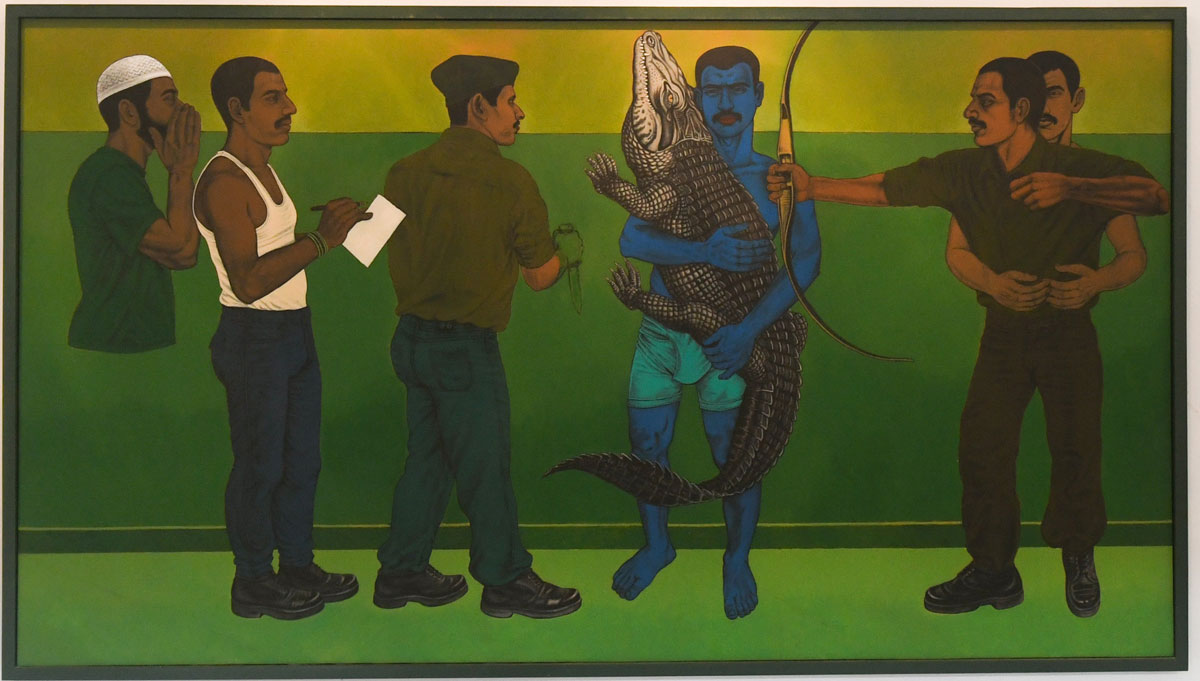
A Casual State of Being in a Soul Hunting Haven, 2017.
Acrylic on canvas
152 x 274 cm.
Courtesy the artist
Arif Mahmood
Born in 1960 in Karachi (Pakistan)
Lives and works in Karachi (Pakistan)
Arif Mahmood is a photographer specialising in photojournalism, portraiture and fashion. He holds a Bachelor’s degree in Business Administration from Otterbein College, Ohio. Upon his return to Karachi in 1985, he took up photography, and within five years he was contributing editorial work for all major Pakistani publications. International publications that have published his work include: Newsweek; Khaleej Times; Gulf News; Arabian Woman Magazine; and Private Magazine. Arif has 27 publications to his credit, and had had 14 solo exhibitions in Pakistan and abroad, to date. He has also participated in 56 group shows nationally and internationally, and his photographs are in the permanent collection of the Museum of Fine Arts, Houston. His art practice is very much based in his professional interests, combining aspects of photojournalism, fashion photography and portraiture in his work.
His photographic collage, Balochistan Earthquake 2008, comprises of 15 black and white photos taken whilst covering the Ziarat Earthquake in early November 2008. Rather than capturing the devastation and destruction that ensued following the 6.4 magnitude earthquake, Arif has focused on the human aspect of the natural disaster. Subverting the viewer’s expectations, his beautifully shot monochrome photographs do not portray images of human distress and pain, rather, they depict the pure resilience of human spirit in the face of such adversity. The figures in his photographs act as metonyms for the greater plight of all those affected and displaced by the earthquake, yet the viewer comes away from the work with a distinct sense of optimism, due to the positivity and fortitude that radiates from the various players on Arif’s photographic stage.

Balochistan Earthquake 2008, 2008.
Photographs, black and white film, handmade silver gelatin prints
Collage of 15 photographs, 290 x 244 cm.
Courtesy the artist
Arsalan Nasir
Born in 1990 in Karachi (Pakistan)
Lives and works in Karachi (Pakistan)
Arsalan Nasir obtained his Master’s Degree in Art & Design Studies, from Beaconhouse National University, Lahore, in 2017 where he received the UMMESA South Asia Scholarship Award. He received his BFA (with Distinction) from the University of Karachi in 2013. He has exhibited his work in several group exhibitions in Pakistan, the most recent of which was at the Dutch Embassy in Islamabad. He has also participated in several artist residencies, including: the first Sanat Residency, Karachi; and the Social Sculpture Residency at Vasl, Karachi, in collaboration with Heinrich Boll Stiftung. He is currently working as a Scale Model Artist at KSEW Pakistan Navy. A multi-disciplinary artist, Nasir’s technical practice spans drawing, painting, sculpture, printmaking, installation and new media, and his energetic drive to explore new mediums has resulted in his development of interactive technologies within his artwork. The basis of his artistic practice is an exploration of memory, and relaying of memories through everyday stories. He is especially interested in the concept of collective recollections, and the role of imagination in the formation of the personal narratives that constitute our memories, which are subsequently passed down as edifying experiences.
Nasir’s sound installation for the Karachi Biennale 2017, Absent/Present, comprising of a circle of schoolchildren’s backpacks, is an investigation into the way in which we embed memories in an existing space. The project explores the nostalgia elicited by re-encountering objects and spaces of prior significance, which in turn triggers memories, personal narratives and specific experiences, creating an internal dialogue between recollection and the actuality of the past. Thus, the school bags, emitting sounds when the motion sensors within are triggered, provide a visual and sonic representation of the capacity of a space or an object provoke a collective recollection, mediating a dialogue between the past, individual narratives, shared experiences and the subjectivity of memories.
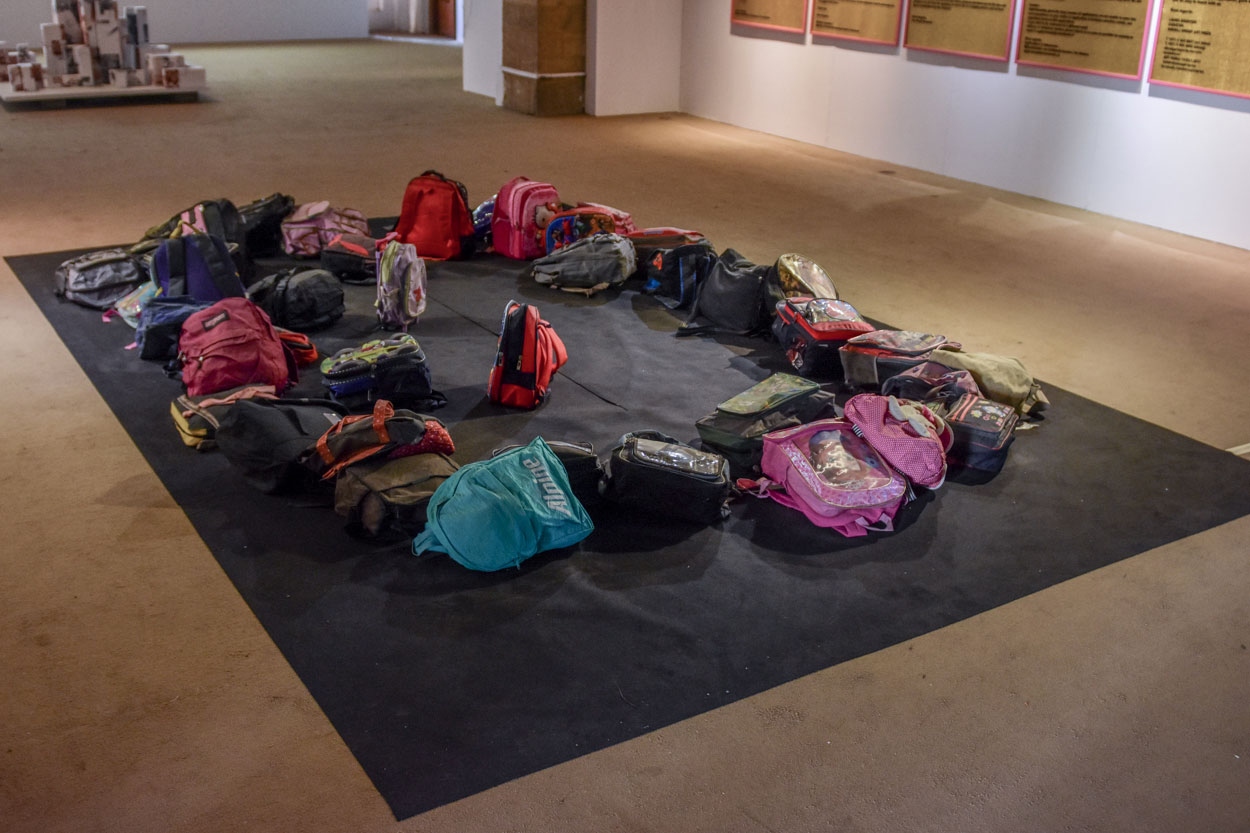
Absent/Present, 2017.
Sound installation, school bags, sensors and speakers
Dimensions variable
Arshad Faruqui/Nurayah Sheikh Nabi/Saba Iqbal
Arshad Faruqi (b. 1964, Karachi) graduated with a degree in architecture from the Dawood College of Engineering and Technology, Karachi, in 1988. He worked with renowned Architect Habib Fida Ali and then went on to receive his Master’s degree from the Illinois Institute of Technology in 1992. He is a practicing architect, landscape designer and adjunct faculty member at the Indus Valley School of Art and Architecture. He lives and works in Karachi. Nurayah Sheikh Nabi (b. 1971, Rawalpindi) graduated from the National College of Art, Lahore in 1993. Her work has been exhibited both internationally as well as within Pakistan. Her recent works have been shown internationally at the Venice Biennial 2017 as part of the Imago Mundi project and at the Deck Gallery, Singapore (2016) and at the Sharjah Museum (2015). She lives and works in Karachi. Saba Iqbal (b. 1970, Karachi) received her BFA from the Indus Valley School of Art and Architecture (IVSAA) Karachi in 1994 and then went on to do a Graduate Diploma of Communications (Interactive Multimedia Technologies) from Edith Cowan University, Perth, Australia in 2002. She has been part of the faculty at the IVSAA, Karachi since 2003 teaching sculpture and printmaking. Iqbal has participated in numerous shows both group and solo. She lives and works in Karachi.
The artists write of the work they created for KB17: “Though rapidly dwindling, we occasionally witness the traditional, typical milk containers, stacked one on top of the other, jam packed on vans, carts and rickshaws and even on motorbikes. Varying in size and depending on their capacities, these containers once encountered on a daily basis are now just sporadic witnesses to, and a comment on, the past. They bring forward questions on old versus new, organic versus inorganic and pure versus adulterated. It is now a reality that packaged goods enjoy most of our attention and the milk industry too has raced towards the promise of hygiene and convenience. However, the illusion of health deceives the mind and pleases the eye with brightly colored boxes readily available at stores. Does this trend for consumerism have an expiry date?”
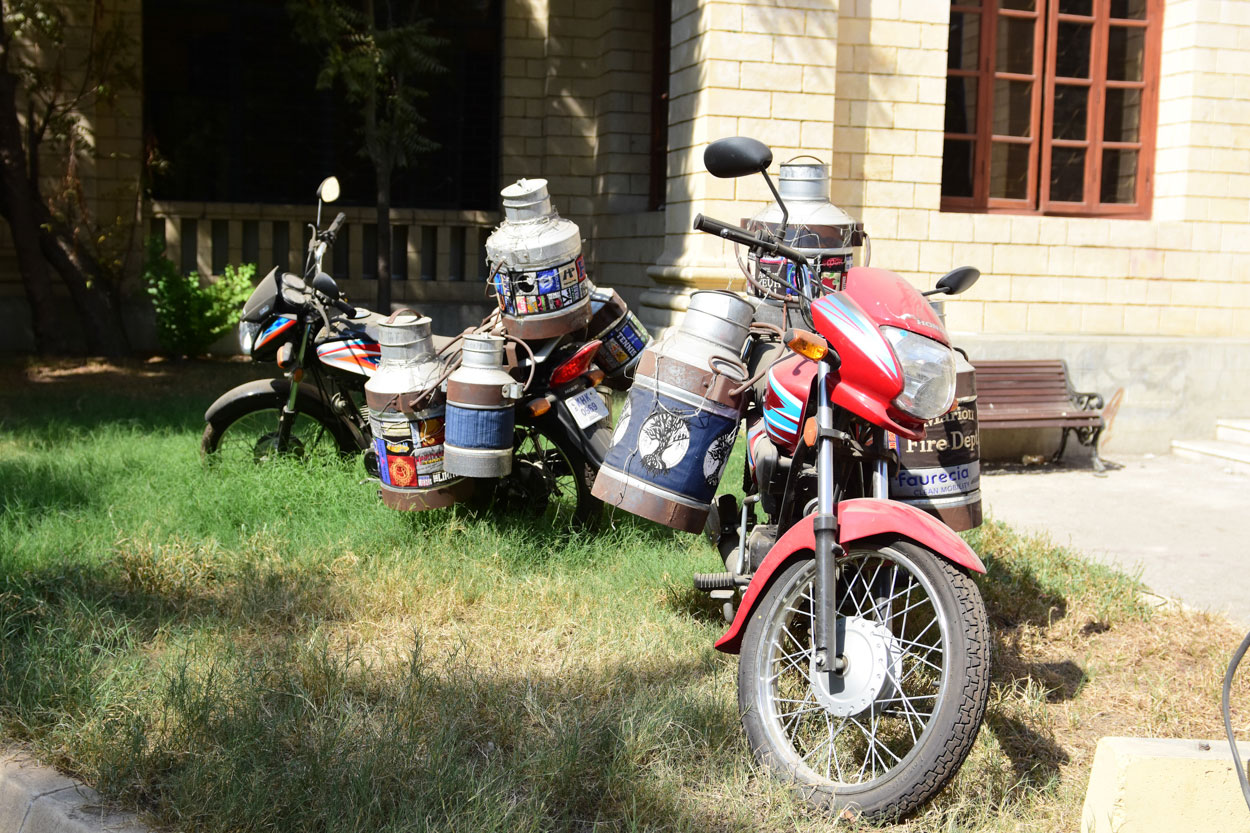
Doodh ka Doodh aur Paani ka Paani, 2017.
Milk containers with embroidery and silkscreen on denim and canvas
Dimensions variable
Courtesy the artists
Ayaz Jokhio
Born in 1978 in Mehrabpur (Pakistan)
Lives and works in Lahore (Pakistan)
Ayaz Jokhio obtained his BFA (with distinction) from the National College of Arts, Lahore in 2001. He dissects the grammar of images with a certain intellectual logic and uses for his artistic works an amalgamation of imagery from print media, the Internet, and popular culture along with his own observations of contemporary Pakistan. Jokhio uses installation, drawing, painting, and text to pose questions about the ways in which we regard and represent our world, often also commenting on the conventions of gallery display. His work has been shown in numerous group and solo exhibitions in Pakistan and abroad, and he has been a resident artist in Switzerland, Germany and Japan. Ayaz Jokhio teaches at the Mariam Dawood School of Visual Arts and Design, Beaconhouse National University in Lahore.
Of his work for KB17 Ayaz Jokhio writes: “I never enjoy talking about or explaining my work. It is like explaining a joke, which makes no one laugh. This is the first time that I am trying to create an art piece with puppets. Puppetry has always been there in my heart, but always like a secret crush on someone. My installation for KB is an imitation of a common classroom setting in our public schools: students sitting in rows at their desks -- but replaced by marionettes/puppets. When someone opens the door and enters the classroom, all the puppets stand up like we all do during our student life in a classroom when a teacher or an elder enters. In my work, all the puppets are connected to the door through a mechanism of strings and pulleys. So basically when someone opens the door, it pulls the strings connected to the puppets and they all stand up. And when the door closes, the puppets all sit back down again. I have not followed the advice of many of my friends to make the puppets life-size, like real children. To me, they should be smaller than life so that they can look like puppets and not like real kids. Because the whole idea is to use puppets as a metaphor for what our educational system is trying to make out of our children.”
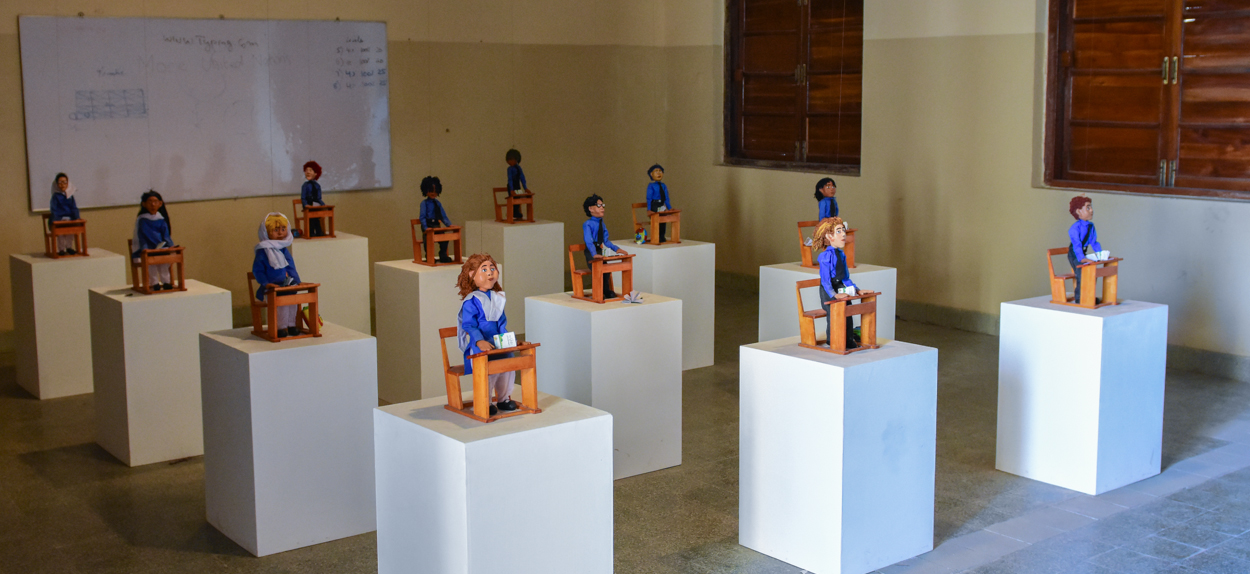
Untitled, 2017.
Mixed media
Dimensions variable
Courtesy the artist
Ayessha Quraishi
Born in 1970 in Karachi (Pakistan)
Lives and works in Karachi (Pakistan)
Ayessha Quraishi is a self-taught painter. She received her initial art training from Karachi-based educator Nayyar Jamil. Her solo shows include “Open Presence,” KOEL Gallery, Karachi (2016); “Liminal,” Khaas Art Gallery, Islamabad (2013); “Continuous / Present,” Rothas II, Lahore (2013); and “Letters From An Underground Vein Read,” KOEL Gallery, Karachi, (2012). She has also participated in Biennial Izimir (2011); the Bodrum Biennial (2013); and Mostra Internazionale di Pittura, Matera, Italy (2014). Her residences include “Recorded Time,” KOEL Gallery (2017); “Hic – 2” Workshop, Turgutreis / Bodrum, Turkey, (2013); Winter Academy, Fayoum, Egypt (2011); International Painting Symposium, Luxor, Egypt (2010) and Association Saint-Henri, France (1996).
Ayessha Quraishi writes of her photographic project for KB17: “I started photographing hoardings seven years ago. The scale of the metal grid and how it framed the sky fascinated me. I felt these empty frames mirrored the perspectives of individual lives that see a slice of the picture, not the entire panorama. Through the frames, I would often watch the grey Karachi sky change colour. Occasionally, I would spot kites glide through them, never knowing on which side of the structure the birds were until they became larger or smaller. Some disappeared. I felt that we too pass through life like birds traversing empty frames. Though the sky was often nondescript, I felt the empty frames offered me a space for reflection. Soon, the breathing space that allowed reverie was occupied and the sky in my eye shrunk. Due to the absence of a local government system, there was no regulator to oversee the mushrooming of billboards in the city. By 2015 Karachi had almost turned into a giant advertisement with every street littered with huge hoardings, many on structures so flawed they led to repeated loss of lives. On May 5th 2016 the Supreme Court maintained that there was no law that permits installing outdoor advertising on billboards, hoardings and signboards on public property and ordered the Karachi Metropolitan Corporation, the Defence Housing Authority and all the cantonment boards to remove hoardings across the city by June 30th 2016. They were taken down but left by the roadsides and empty plots. A year later they still lie there.”
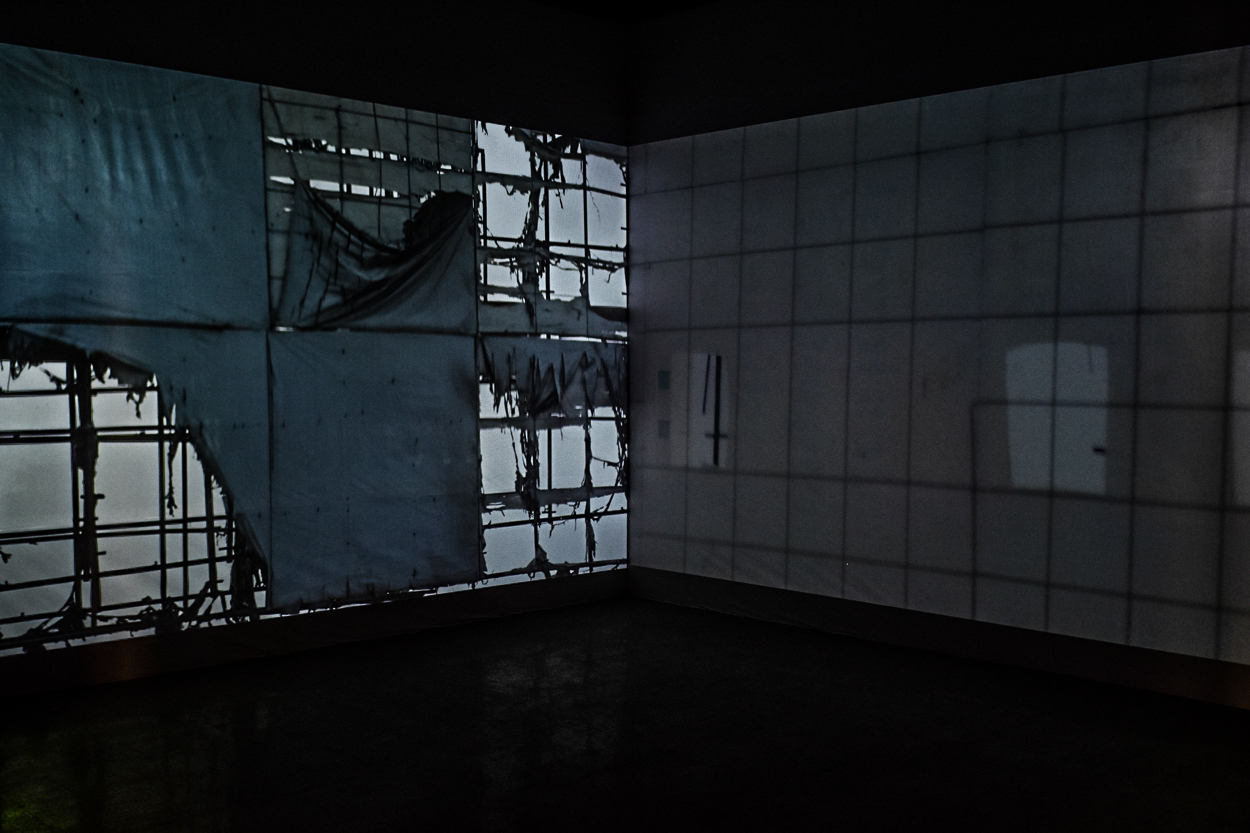
Sky Frames, 2017.
Photographic prints
220 x 110 cm each
Courtesy the artist

Ayman Oghanna
Born in 1985 in London (UK)
Lives in Athens (Greece) and works throughout the Middle East
Ayman Oghanna
Born in 1985 in London (UK)
Lives in Athens (Greece) and works throughout the Middle East
Ayman Oghanna is a journalist and photographer who specializes in the Middle East. Half-British, half-Iraqi, he now lives in Greece. After earning an M.A. in International Relations and Middle East Studies from the University of St Andrews, Oghanna worked for The Daily Star newspaper in Lebanon, before leaving to study journalism at Columbia University in New York. He moved to Iraq in 2009 to begin working as a freelance journalist. He has since covered much of the Arab World. His stories, photographs and videos have appeared in many publications, including The New York Times, The Washington Post, The Wall Street Journal, The Guardian, The Sunday Telegraph, Newsweek, National Geographic, VICE and Al Jazeera America. He is proud to be a founding member of the Frontline Freelance Register, dedicated to protecting and uniting freelancers reporting in foreign countries and conflict zones.
Ayman Oghanna writes of his three photographs on view at KB17: “I am exhibiting work from Iraq, where I began my career exploring my father’s country. My father left the country in the 1970s, Asir al Tahabi, the Golden Age. The Iraq I discovered, however, looked very different from the one he left behind, nearly having car-bombed, kidnapped and executed itself into oblivion. I’ve documented the country since the American occupation and Iraq has known little prosperity since, witnessing an endless cycle of violence recently manifesting itself with the rise and fall of the so-called Islamic State. Torn between opposing forces vying for influence in the Middle East, the country remains fragile, flawed and complex. These images offer an insight, however brief, into the country, its pain and its hope. Unfortunately, I do not think it will be truly at peace in my lifetime, however, I will continue to carry on documenting its struggle for a better future and bear witness to its stories.”

Rescue of an Elderly Civilian, 2016.
Photograph
Courtesy of Ayman Oghanna
Bani Abidi
Born in 1971 in Karachi (Pakistan)
Lives and works in Berlin (Germany)
Bani Abidi uses video and photography to comment upon politics and culture, often through humorous and absurd vignettes. Her work has been exhibited widely in solo and group shows internationally. Solo shows have taken place at Dallas Contemporary, Dallas, Texas, Kunstverein Arnsberg, The Baltic, Gateshead, Experimenter, Kolkata, Green Cardamom, London, amongst others. Select group shows include the 8th Berlin Biennial for Contemporary Art, 2014; In Plain Sight, Smack Mellon, New York, 2014; Lines of Control, Nasher Museum, Duke University, 2013; No Country, Guggenheim Museum, New York, 2013; dOCUMENTA 13, 2012; Kochi Muziris Biennial, 2012; Blockbuster: Cinema for Exhibitions, Mexico, 2011; Where Three Dreams Cross, Whitechapel Art Gallery, London, 2010; Xth Lyon Biennale, Lyon, France, 2009; 7th Gwangju Biennale, Kwangju, South Korea, 2008; Thermocline of Art: New Asian Waves, ZKM, Karlsruhe, Germany, 2007; Singapore Biennale, Singapore, 2006; SubContingent: The South Asian Sub Continent in Contemporary Art, Fondazione Sandretto Re Rebaudengo, Turin, Italy, 2006; Contemporary Commonwealth, National Gallery of Victoria, Australia, 2006; and 3rd Fukuoka Asian Art Triennale, Fukuoka, Japan, 2005, amongst several others. Abidi’s work is in collections of the Museum of Modern Art, New York, Guggenheim Museum, New York, The British Museum, TATE Modern, The Spencer Museum of Art, The Fukuoka Asian Art Museum, The Burger Collection, Devi Arts Foundation, and Marguelies Collection amongst several other private and public collections. She was artist in Residence at DAAD Artists Residency, Berlin in 2011/2012.
Bani Abidi writes of her video installation on view at KB17: “The city has come to a halt. A state dignitary is about to arrive. Traffic is blocked to make way for the unhampered movement of four luxury vehicles. School children with crumpled paper flags in hand wait patiently to wave at the passing motorcade. An anxious reception committee of officious bureaucrats paces up and down a red carpet.”
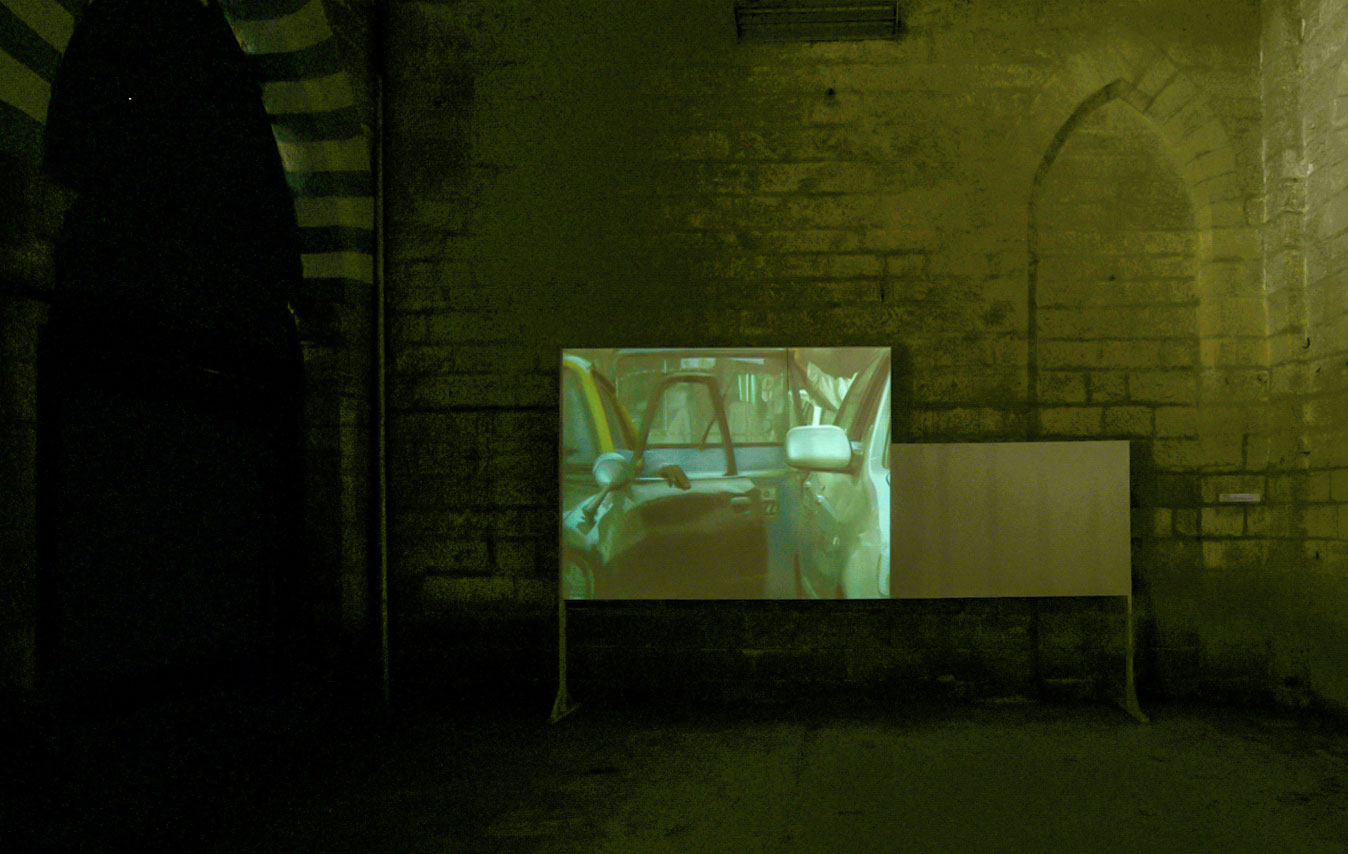
RESERVED, 2006.
Double channel video installation, 9:00 min.
Commissioned by the Singapore National Arts Council for the Singapore Biennale 2006.
Courtesy the artist

